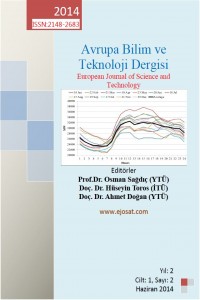Evaluation of Energy Performance Building Construction Standards of The European Union: Example of Kayseri
Öz
In this study, different locations of Turkey in the European Union standards of built complex structures the levels of energy performance of the buildings and sustainability thanks to Ministry of Environment and Urban Planning BEP-TR (Building Energy Performance) Program calculated what the impact of changes in the outcomes of regional sustainability may be examined.
In this context, the project data of buildings (the values of technical building geometry, heating, lighting, mechanic and vetilating) and BEP-TR (Building Energy Performance) Program, entering buildings, the amount of net energy for heating and cooling needs of the buildings, taking into account the effects of sunlight, daylight are not effective while untapped for the areas of lighting energy demand and consumption of carbon emissions buildings shall be determined by calculation and With the data obtained from the evaluation of the sustainability of the structures built in different regions, all the energy of the structure of programs, etc. The data obtained through given the costs will be met from the national budget will bring you to reduce the burden and cost of what measures could be taken to be, intended to be built on the basis of EU standards, given the structures of the energy that will be important to determine the class.
Anahtar Kelimeler
Building Enegy Performance Building Energy Certification BEP-TR Sustainability.
Kaynakça
- Al-Homoud M. S., "Computer-aided building energy analysis techniques", Building and Environment, 421-433 (2001).
- Atmaca M., Kalaycıoğlu E., Yılmaz Z. A., " Building Energy Performance Calculation Method (BEP-TR) and Hotel Performance Evaluation of Buildings ", X. National Installation Engineering Congress, İzmir, 811-826 (2011).
- Aykal D., Gümüş B., Özbudak Y. B., " Scope of Application of Renewable and Efficient Energy Use in Buildings Sustainability ", V. Symposium on Renewable Energy Sources, Diyarbakır 78-84 (2009).
- Ding G., Forsythe P. J., "Sustainable construction: life cycle energy analysis of construction on sloping sites for residential buildings", Construction Management and Economics, 254-265 (2013).
- Drury B. Crawleya, Linda K. Lawrieb, Frederick C. Winkelmannc, W.F. Buhlc,Y.Joe Huangc, Curtis O. Pedersend, Richard K. Strandd, Richard J. Liesend, Daniel E. Fishere, Michael J. Wittef, Jason Glazerf, "EnergyPlus: creating a new-generation building energy simulation program", Energy and Buildings, 319-331 (2001).
- E. Velasco, F. Varela, "Building Energy Analysis (BEA): A methodology to assess building energy labelling", Energy and Buildings, 709-716 (2007).
- Eskin N., " Annual Energy Needs Analysis of Non-Residential Buildings ", İTÜ, İstanbul, 1-6 (2011).
- Gali G., Corgnati P. S., Yılmaz Z. A., " Analysis of the complex of buildings in terms of energy certification: Comparison of Standard and Advanced Simulation Tools ", X. National Installation Engineering Congress, İzmir, 795- 807 (2011).
- Ministry of Environment and Urbanization, " Building Energy Performance Calculation Method Utility User's Guide ", Ankara, 1-64.
- Turkish National Police, Department of Foreigners Borders and Asylum, Project The Information Note and Projec Treatment", Ankara, 2010.
- Ramesha T., Prakasha R., Shuklab K.K., "Life cycle energy analysis of buildings: An overview", Energy and Buildings, 1592-1600 (2010).
- Santammuris M., Argiriou A., "Renewable energies and energy conservation technologies for buildings in Southern Europe International Journal of Solar Energy, 69-79 (1994).
Avrupa Birliği Standartlarında İnşa Edilen Yapının Enerji Performansının Belirlenmesi: Kayseri Örneği
Öz
Bu çalışmada, Avrupa Birliği normları esas alınarak inşa edilen kompleks bir binanın enerji performans kimliği araştırılmaktadır. Bu yapı, Çevre ve Şehircilik Bakanlığı'na ait BEP-TR (Bina Enerji Performansı) Programı kullanılarak enerji performans değeri ve enerji kimlik belgesi açısından değerlendirilmektedir.
Anahtar Kelimeler
Binalarda Enerji Performansı Bina Enerji Performansı Programı (BEP-TR) Sürdürülebilirlik
Kaynakça
- Al-Homoud M. S., "Computer-aided building energy analysis techniques", Building and Environment, 421-433 (2001).
- Atmaca M., Kalaycıoğlu E., Yılmaz Z. A., " Building Energy Performance Calculation Method (BEP-TR) and Hotel Performance Evaluation of Buildings ", X. National Installation Engineering Congress, İzmir, 811-826 (2011).
- Aykal D., Gümüş B., Özbudak Y. B., " Scope of Application of Renewable and Efficient Energy Use in Buildings Sustainability ", V. Symposium on Renewable Energy Sources, Diyarbakır 78-84 (2009).
- Ding G., Forsythe P. J., "Sustainable construction: life cycle energy analysis of construction on sloping sites for residential buildings", Construction Management and Economics, 254-265 (2013).
- Drury B. Crawleya, Linda K. Lawrieb, Frederick C. Winkelmannc, W.F. Buhlc,Y.Joe Huangc, Curtis O. Pedersend, Richard K. Strandd, Richard J. Liesend, Daniel E. Fishere, Michael J. Wittef, Jason Glazerf, "EnergyPlus: creating a new-generation building energy simulation program", Energy and Buildings, 319-331 (2001).
- E. Velasco, F. Varela, "Building Energy Analysis (BEA): A methodology to assess building energy labelling", Energy and Buildings, 709-716 (2007).
- Eskin N., " Annual Energy Needs Analysis of Non-Residential Buildings ", İTÜ, İstanbul, 1-6 (2011).
- Gali G., Corgnati P. S., Yılmaz Z. A., " Analysis of the complex of buildings in terms of energy certification: Comparison of Standard and Advanced Simulation Tools ", X. National Installation Engineering Congress, İzmir, 795- 807 (2011).
- Ministry of Environment and Urbanization, " Building Energy Performance Calculation Method Utility User's Guide ", Ankara, 1-64.
- Turkish National Police, Department of Foreigners Borders and Asylum, Project The Information Note and Projec Treatment", Ankara, 2010.
- Ramesha T., Prakasha R., Shuklab K.K., "Life cycle energy analysis of buildings: An overview", Energy and Buildings, 1592-1600 (2010).
- Santammuris M., Argiriou A., "Renewable energies and energy conservation technologies for buildings in Southern Europe International Journal of Solar Energy, 69-79 (1994).
Ayrıntılar
| Birincil Dil | İngilizce |
|---|---|
| Konular | Mühendislik |
| Bölüm | Makaleler |
| Yazarlar | |
| Yayımlanma Tarihi | 5 Temmuz 2014 |
| Yayımlandığı Sayı | Yıl 2014 Cilt: 1 Sayı: 2 |


